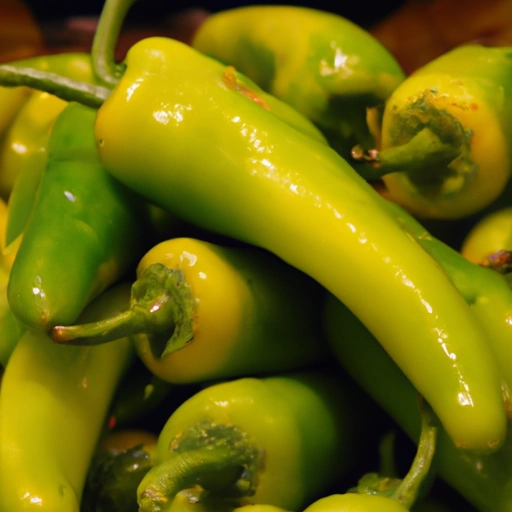Pepperoncini
Description

Pepperoncini, also known as Tuscan peppers, golden Greek peppers, or banana peppers, are a variety of mild chili pepper that belong to the species Capsicum annuum. Typically harvested before they reach full maturity, these peppers are most commonly found pickled in a brine of vinegar and salt. They are known for their slightly sweet taste and mild heat, which ranges from 100 to 500 Scoville heat units. With their tangy flavor and crunchy texture, pepperoncini are a versatile ingredient used in a myriad of dishes across various cuisines.
Common uses
Pepperoncini are commonly used to add a mild spiciness and tang to dishes without overwhelming the other flavors. They are often found in salads, particularly Greek salads, as well as sandwiches, pizzas, antipasto platters, and with kebabs. Pickled pepperoncini are also served as a condiment or as part of a relish tray.
Nutritional value
Calories
Pepperoncini are low in calories, with approximately 10 calories per pepper or about 3 calories per 10 grams.
Protein
A typical serving of pepperoncini contains about 0.2 grams of protein per 10-gram serving.
Fat
These peppers are virtually fat-free, containing only trace amounts of fat.
Carbohydrates
Pepperoncini contain about 2 grams of carbohydrates per 10-gram serving, with some of that coming from dietary fiber.
Vitamins
Pepperoncini are a good source of vitamin A and vitamin C, vital for maintaining good health and immunity.
Minerals
They also contain minor amounts of minerals such as calcium and iron.
Health benefits
The vitamin C content in pepperoncini can contribute to immune system support, antioxidant action, and skin health. Additionally, the capsaicin in these peppers may promote better circulation and have anti-inflammatory effects.
Potential risks
While pepperoncini are generally considered safe to eat, overconsumption may lead to gastrointestinal upset in some individuals. People with pepper allergies or intolerances should avoid them.
Common recipes
Pepperoncini are a staple in Greek salads and Italian antipasto. They are also sliced and used as toppings for pizzas and sandwiches or stuffed with cheese and meats.
Cooking methods
Most often, pepperoncini are consumed pickled, but they can also be used fresh, roasted, or sautéed to add flavor to various dishes.
Pairing with other ingredients
These peppers pair well with feta, mozzarella, cured meats, olives, and fresh vegetables.
Summary
Pepperoncini are a mildly spicy and tangy chili pepper that enhances a variety of dishes with their unique flavor. They offer nutritional benefits with low calories and are rich in vitamins. While adding zest to recipes worldwide, they should be consumed in moderation to avoid digestive discomfort for those sensitive to spicy foods.